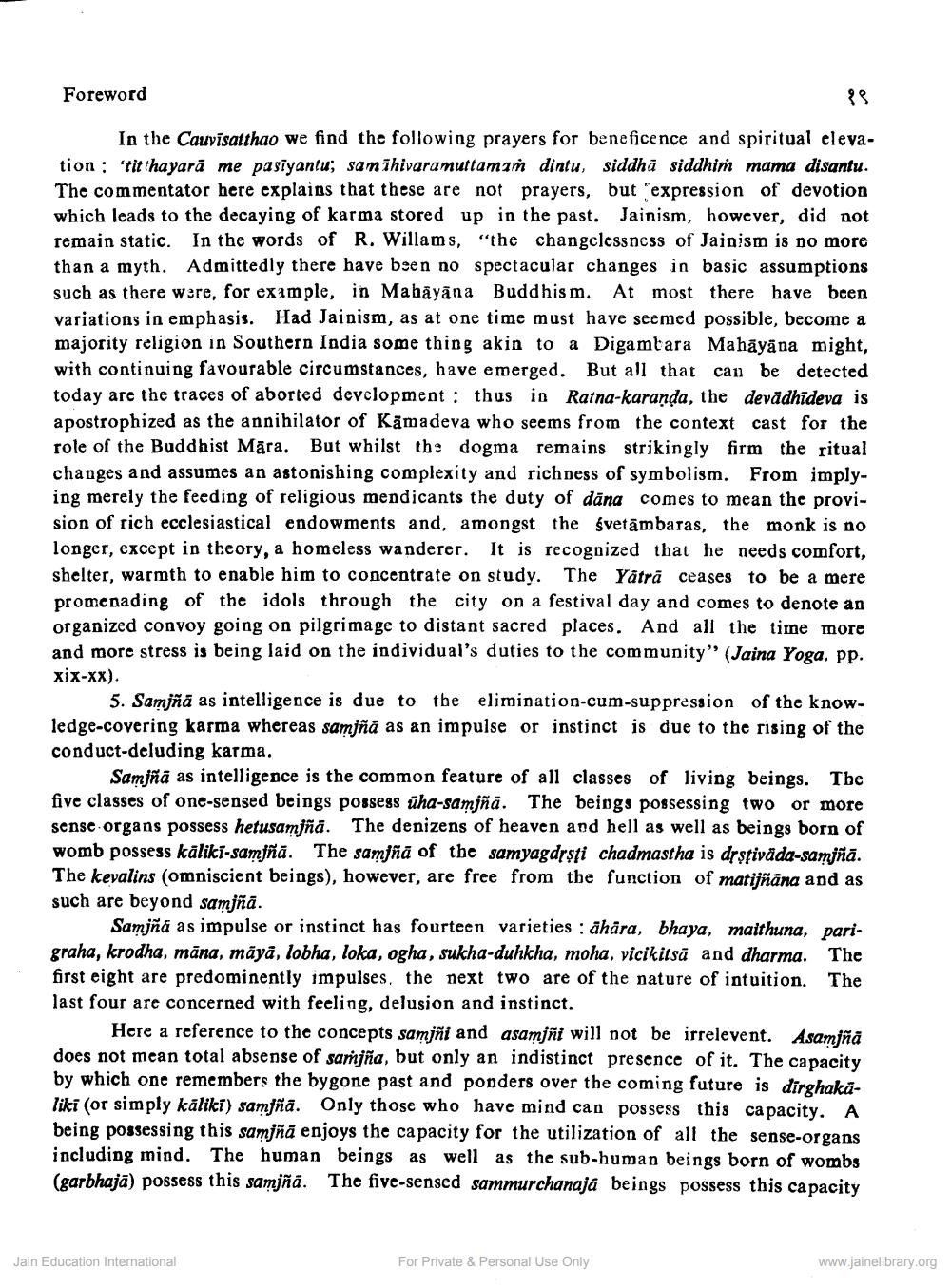________________
Foreword
१९
In the Cauvisatthao we find the following prayers for beneficence and spiritual eleva
tion titthayara me pasīyantu; samīhivaramuttamam dintu, siddha siddhim mama disantu. The commentator here explains that these are not prayers, but expression of devotion which leads to the decaying of karma stored up in the past. Jainism, however, did not remain static. In the words of R. Willams, "the changelessness of Jainism is no more than a myth. Admittedly there have been no spectacular changes in basic assumptions such as there were, for example, in Mahayana Buddhism. At most there have been variations in emphasis. Had Jainism, as at one time must have seemed possible, become a majority religion in Southern India some thing akin to a Digambara Mahayana might, with continuing favourable circumstances, have emerged. But all that But all that can be detected today are the traces of aborted development: thus in Ratna-karanda, the devādhīdeva is apostrophized as the annihilator of Kamadeva who seems from the context cast for the role of the Buddhist Mara. But whilst the dogma remains strikingly firm the ritual changes and assumes an astonishing complexity and richness of symbolism. From implying merely the feeding of religious mendicants the duty of dana comes to mean the provision of rich ecclesiastical endowments and, amongst the vetämbaras, the monk is no longer, except in theory, a homeless wanderer. It is recognized that he needs comfort, shelter, warmth to enable him to concentrate on study. The Yatra ceases to be a mere promenading of the idols through the city on a festival day and comes to denote an organized convoy going on pilgrimage to distant sacred places. And all the time more and more stress is being laid on the individual's duties to the community" (Jaina Yoga, pp. Xix-xx).
5. Samjñā as intelligence is due to the elimination-cum-suppression of the knowledge-covering karma whereas samjñā as an impulse or instinct is due to the rising of the conduct-deluding karma.
Samjñā as intelligence is the common feature of all classes of living beings. The five classes of one-sensed beings possess aha-samfñd. The beings possessing two sense organs possess hetusamjñā. The denizens of heaven and hell as well as beings born of womb possess kāliki-samjñā. The samfña of the samyagdrsti chadmastha is drstivada-samjñā. The kevalins (omniscient beings), however, are free from the function of matijñāna and as such are beyond samjiä.
Samjña as impulse or instinct has fourteen varieties: dhara. bhaya, malthuna, parigraha, krodha, mäna, māyā, lobha, loka, ogha, sukha-duhkha, moha, vicikitsä and dharma. The first eight are predominently impulses. the next two are of the nature of intuition. The last four are concerned with feeling, delusion and instinct.
Here a reference to the concepts samjil and asamfit will not be irrelevent. Asamjña does not mean total absense of samjha, but only an indistinct presence of it. The capacity by which one remembers the bygone past and ponders over the coming future is dirghakaliki (or simply käliki) samfñd. Only those who have mind can possess this capacity. A being possessing this samfña enjoys the capacity for the utilization of all the sense-organs including mind. The human beings as well as the sub-human beings born of wombs (garbhaja) possess this samjña. The five-sensed sammurchanaja beings possess this capacity
Jain Education International
For Private & Personal Use Only
www.jainelibrary.org




